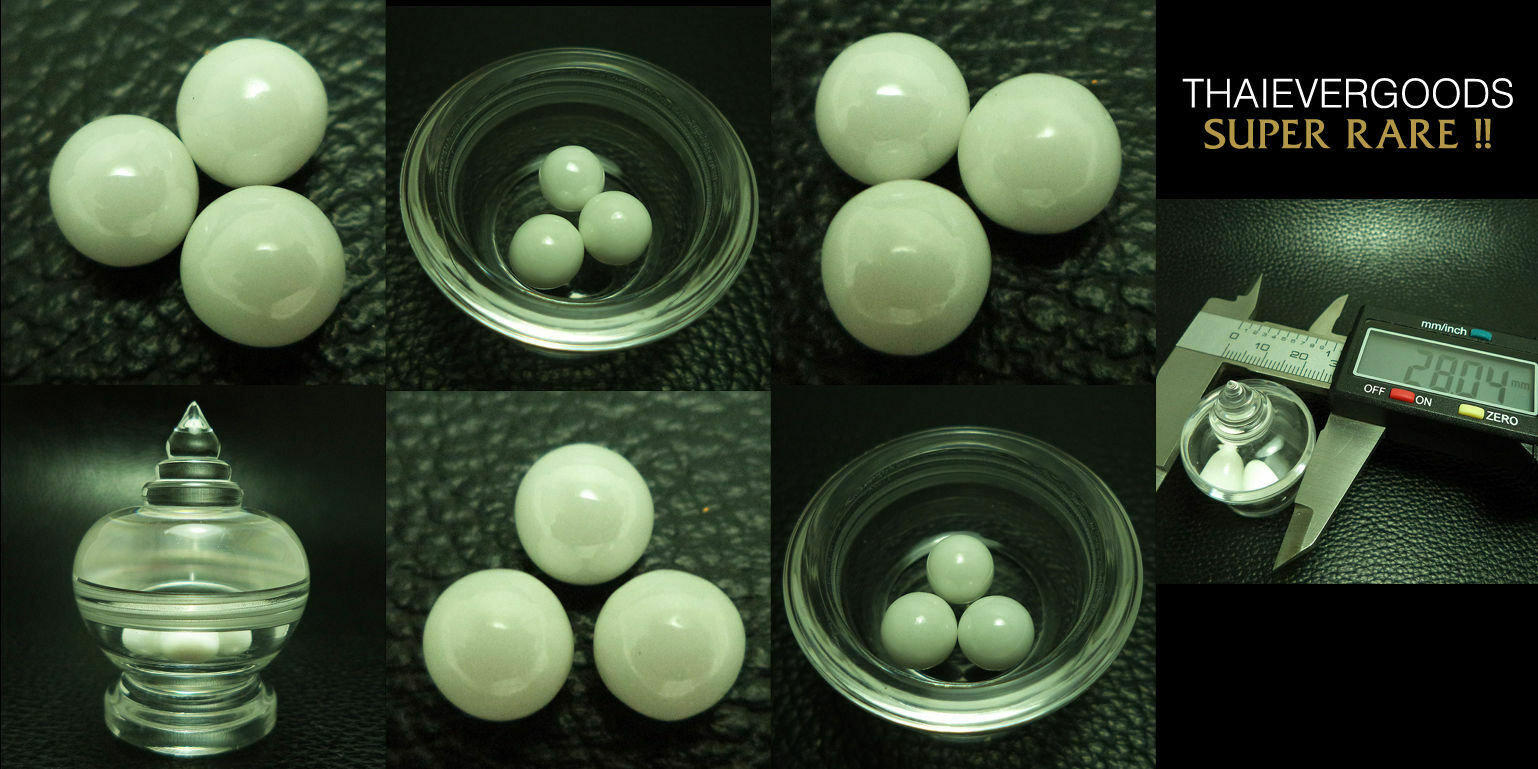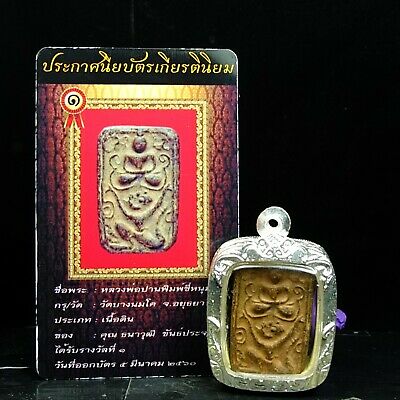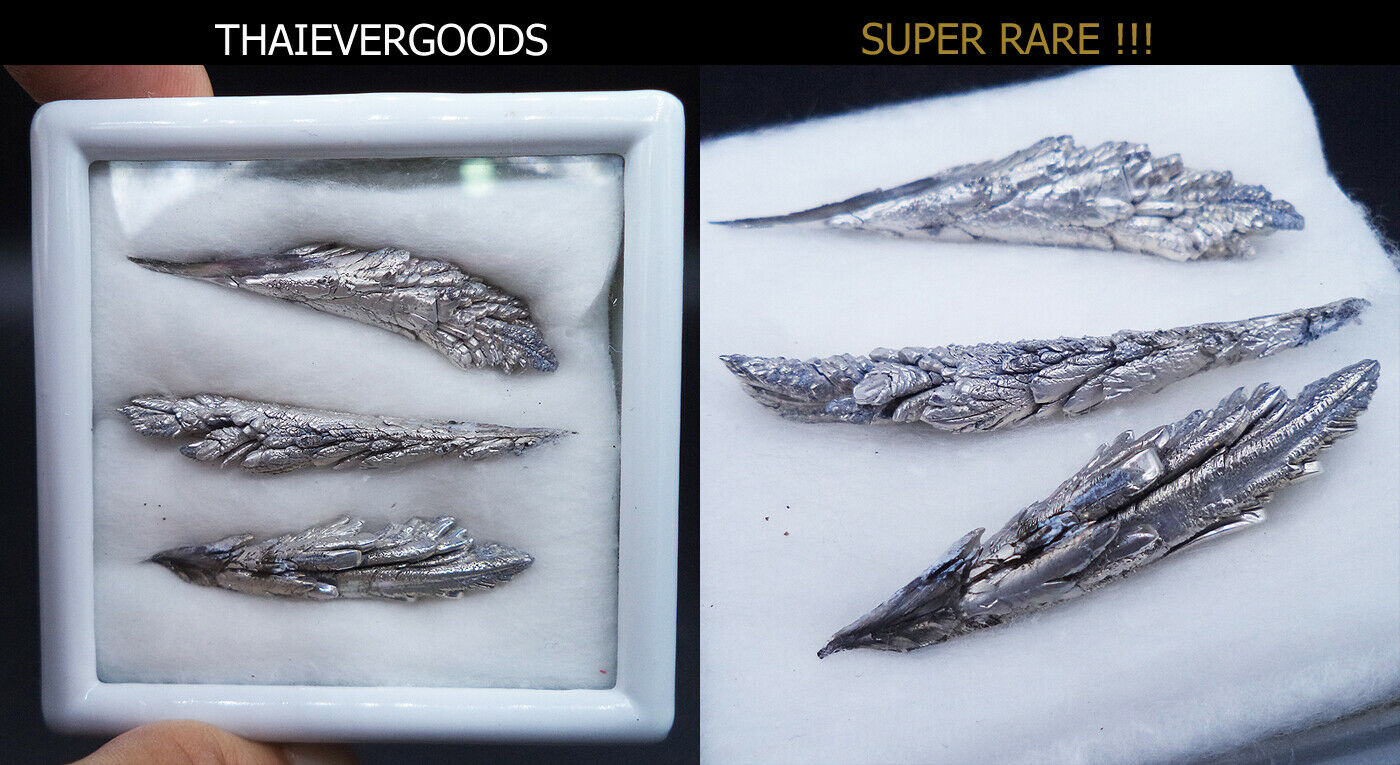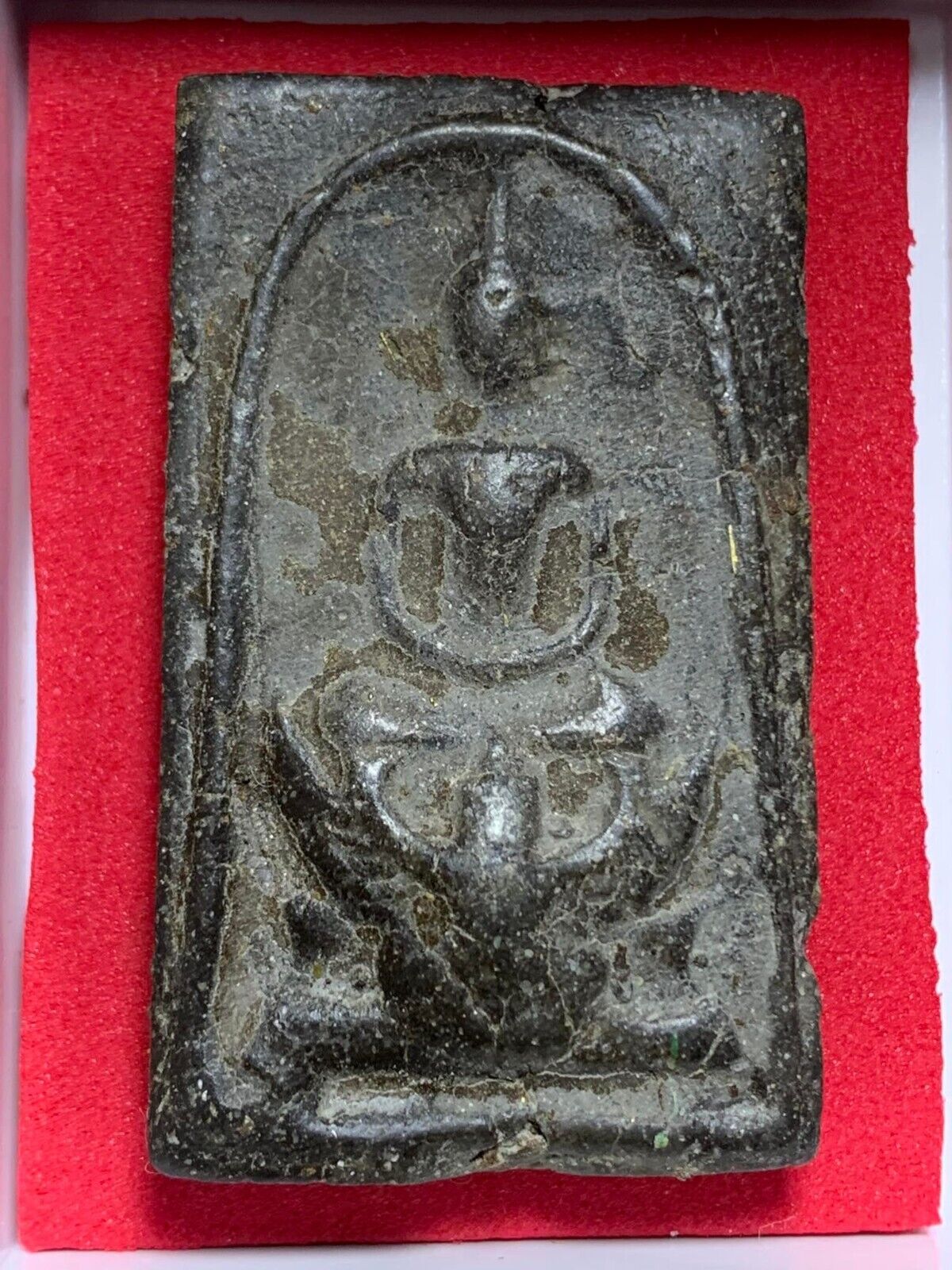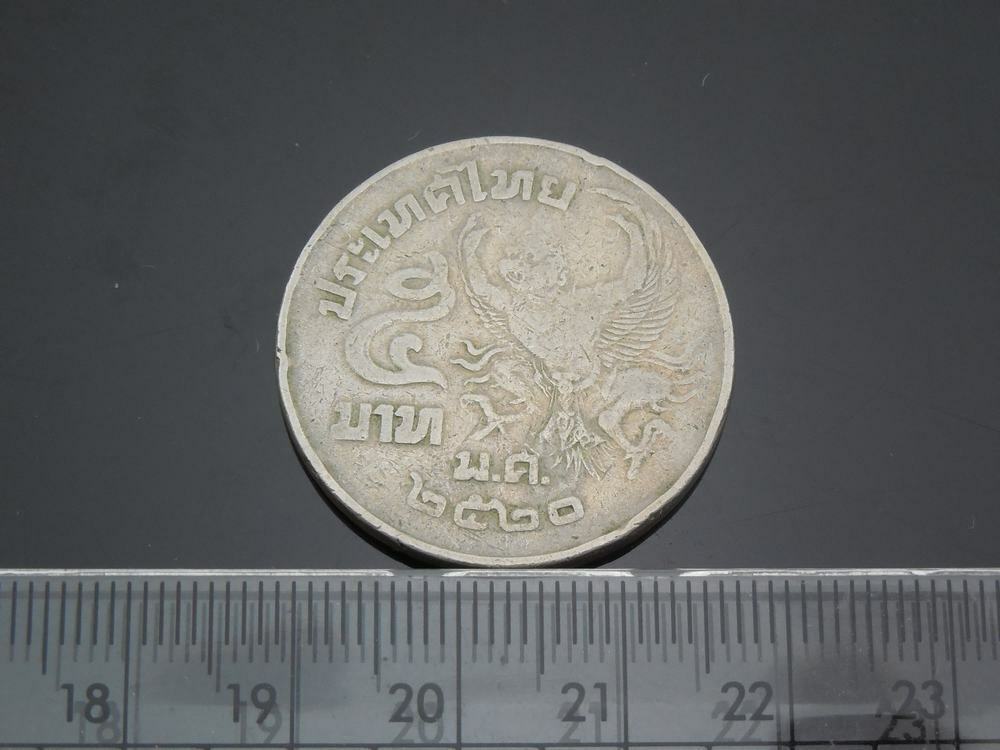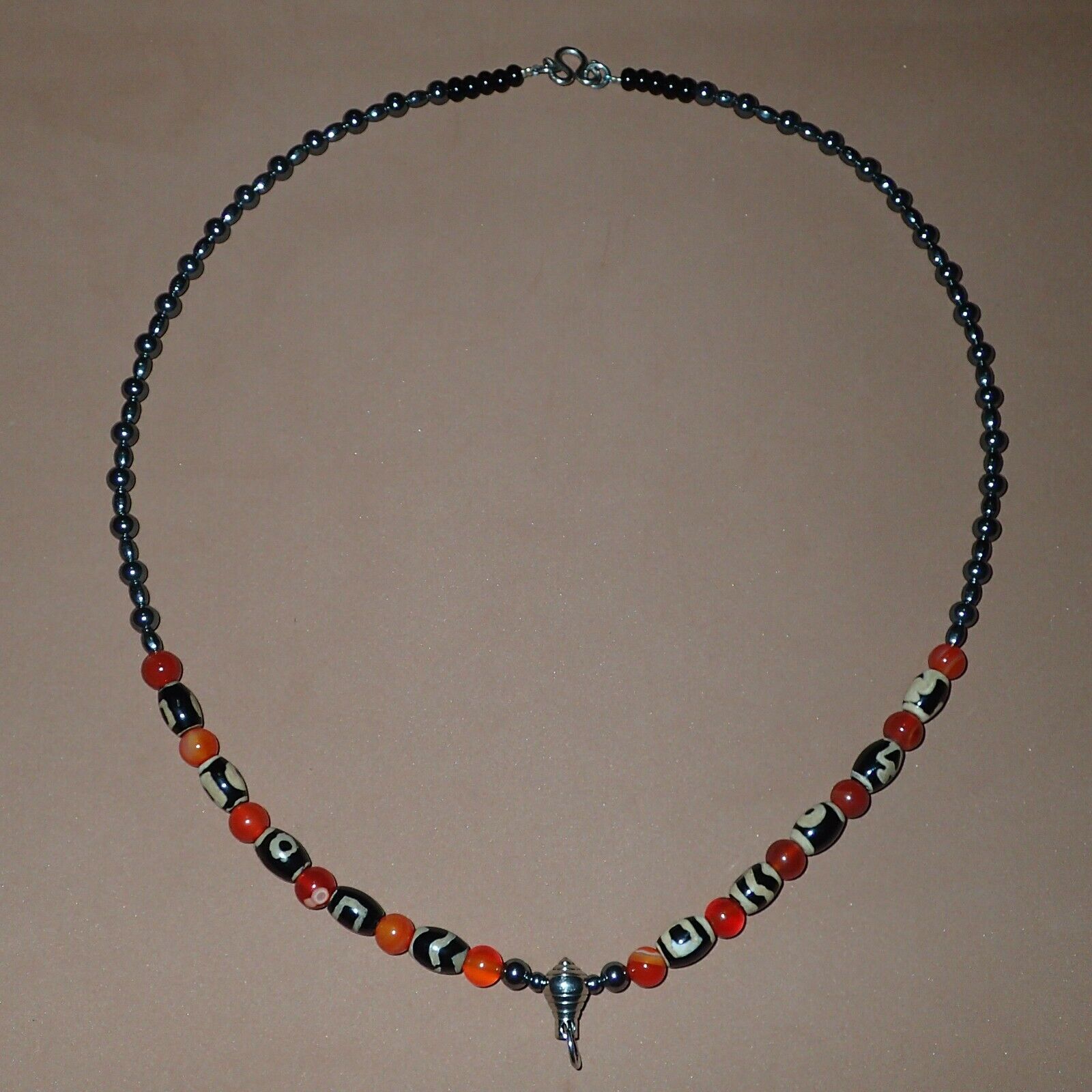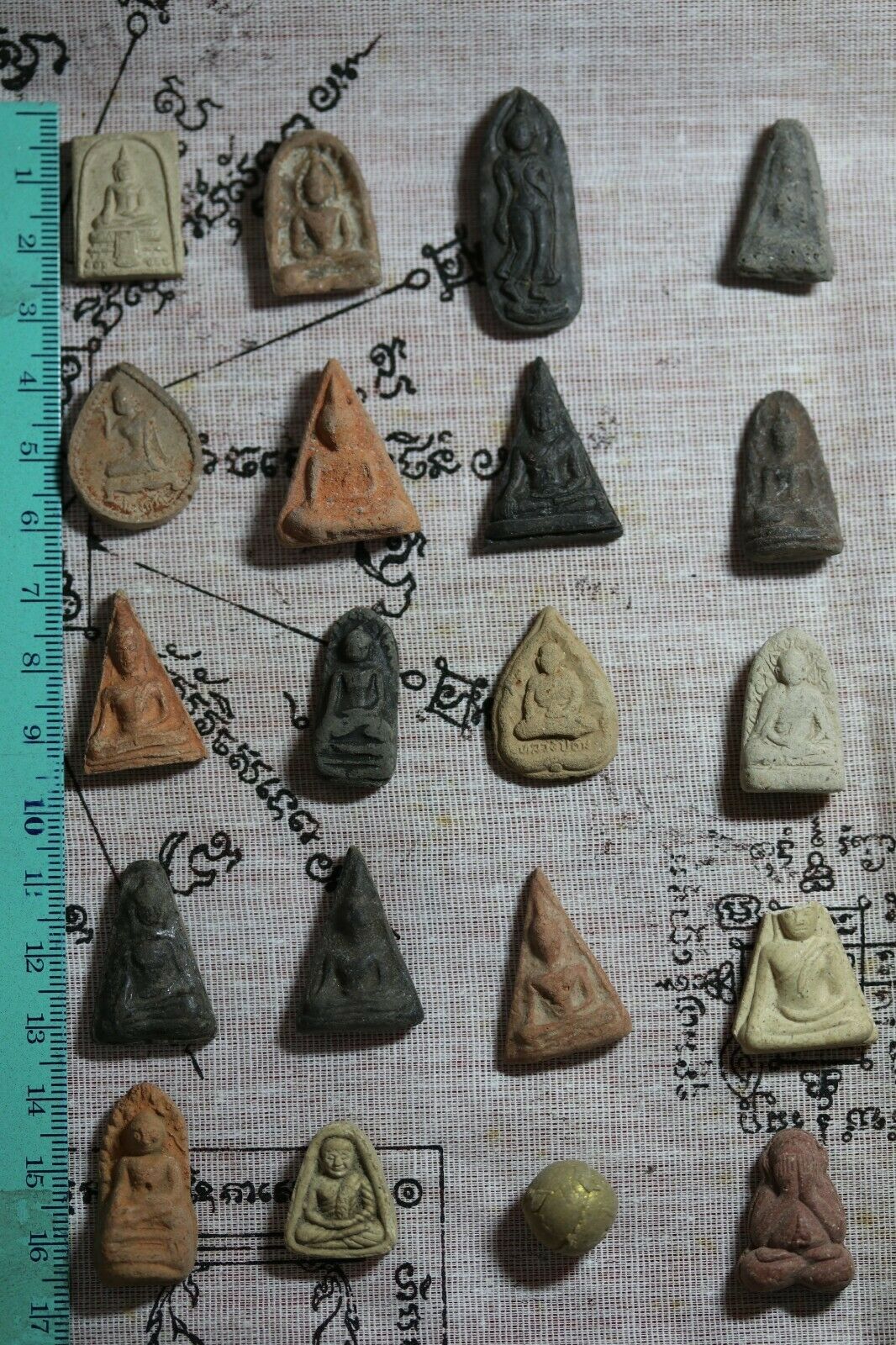-40%
Masterpiece 1 in 99 Certi DD-PRA Phra Kring Real Silver Wat Borom Ringing Bells
$ 421.87
- Description
- Size Guide
Description
***BEST OPPORTUNITY***Amulet Names : Phra Kring Sit That Tho Medicine Buddha (Ringing Bell inside)
Batch : Borom Suk (Thai mean Very Happy)
Masters :-
Disciple of Phra Achan Mun Bhuridatto Maha Thera
(1) Somdej Yan Warodom, Wat Thepsirin
(2) Phra Phrom Muni, Wat Bowonniwet Vihara
(3) Luang Pu Boonyarit
Samnaksong Suan Thip, Nonthaburi
(4) Luang Pu Chanraem, Wat Rahan, Buriram
(5) Luang Ta Phuang, Wat Si Thammaram, Yasothon
(6) Luang Pu Bun Pheng, Wat Pa Wiwek Tham, Khon Kaen
(7) Luang Pu Thon, Wat Pa Si Aphai Wan, Loei
(8) Phra Ratcha Worakhun, Wat Burapha Ram, Surin
(9) Luang Phor Khambo, Wat Pa Ban Tan, Sakon Nakhon
(10) Luang Phor Koon, Wat Pa Phuthon, Udon Thani
(11) Phra Wimon Si La Chan, Wat Borom Niwat, Bangkok
(12) Luang Pu Tim, Wat Phra Khao, Ayutthaya
(13) Luang Phor Ruay, Wat Tha Ko, Ayutthaya
(14) Luang Phor Thong, Wat Rangsi Sut Tha Wat, Chonburi
(15) Luang Pho Choi, Wat Nong Nam Khiao, Chonburi
(16) Luang Pu Kalong, Wat Khao Laem, Saraburi
(17) Luang Pho An, Wat Rong Kho, Uthai Thani
(18) LuangPu Chuea, Wat Klang Bang Kaew, Nakhon Pathom
(19) Luang Phor Sakorn, Wat Nong Krap, Rayong
(20) Phra Ajarn Wichai, Wat Tham Pha Chom, Chiang Rai
(21) Phra Ajran Somphong, Wat Borom Niwat
(22) Phrakhru Kitti, Wat Borom Niwat
and 150 monks around Thailand
Year : Friday 24 March 2549 BE.(2006)
Temple : Wat Borom Niwat Ratchaworawihan
City : Bangkok
Materials : Silver
*Phra Kring Sit That Tho
Gold made 9 pieces
Silver made 99 pieces
Nawaloha made 2,999 pieces
Measures : 3.8 cm
Quantity : 1
Conditions : Excellent
***Certificate of Authenticity by DD-PRA
***Amulet is encased with plastic waterproof case and sealed with 95% real silver case (100% handcrafted silver case product & take three weeks to make it.)
A century-old temple near the heart of Bangkok contains perplexing dhamma- and astronomy-inspired mural paintings.
The mural painting on the interior wall behind Phra Thossapollayan, the principle Buddha statue, in the ordination hall of Wat Borommaniwat depicts the Sun instead of Mount Meru.
Stepping into the ordination hall (ubosot) of Wat Borommaniwat in Bangkok’s Pathumwan district, visitors will be bewildered by the unorthodox mural paintings lining the walls. Wat Borommaniwat is home to Thailand’s first scientific painting of the universe. Combining Thai and Western art, these murals depict the solar system, Saturn and other planets.
“Wat Borommaniwat is the first temple built by King Rama IV. Murals were painted by Khrua In Khong and are dhamma riddles. This temple was later restored by King Rama V,” said Phra Khru Palad Winaiwattana, a monk at the temple.
The murals, painted with powder colour by famed monk artist Khrua In Khong, can be divided into two categories. Those on the walls between the doors and windows depict important Thai traditions, while those on the walls above the doors and windows show dhamma and words of Buddhist wisdom through Western architecture, art and people. There are a total of eight planets shown in these paintings.
Khrua In Khong became renowned during the Fourth Reign. He was the first Siamese to create mural paintings using the perspective principle, light and shadows. He initially created two-dimensional traditional mural paintings, mostly Buddhist references and Jakata tales, like those at Wat Maha Samanaram in his hometown of Phetchaburi and in Ratchakoramanusorn Hall in Bangkok’s Temple of the Emerald Buddha. He later opted for dhamma, as shown on the murals of Wat Borommaniwat and Wat Bowonniwet Vihara, one of the temples in which King Rama IV stayed during his monkhood.
In the ubosot, above the blue- and green-toned paintings of European architecture and Western people are murals of traditional Thai devas (guardian spirits). If you look at some of these murals carefully, you will see several scientifically correct constellations painted in the sky. The Sun is visible on the interior wall behind Phra Thossapollayan, the principle Buddha statue in post-Sukhothai art style. In the upper part of the wall on the right side of the statue, Saturn with its two brightest rings shines in the dark sky. A little below Saturn is a group of devas flying behind white clouds. On the left side of the statue is a large planet believed to be Jupiter, as it contains horizontal stripes of clouds and is surrounded by the four Galilean moons.
King Rama IV is widely known for his ability as an astronomer, able to forecast the exact date and best location to view a solar eclipse in 1868. Yet very few people know that the king assigned Khrua In Khong to create the mural paintings of Saturn and other planets based on Western knowledge of astronomy. The names of several other planets seen in the paintings here remain unknown. Some of these planets were painted with a good understanding of science for having bright and dark sides, thanks to the direction of sunlight.
A sign under the mural painting behind the principle Buddha statue contains words about the Sun. In this painting, the Sun is positioned exactly where Mount Meru (Khao Phra Sumen) and heaven would traditionally be painted. The meanings of these paintings are in accordance with texts inscribed on 12 stone plates above the doors and windows. Each painting is separated from the next by images of trees and people. In general, these paintings compare the Lord Buddha to a doctor who knows how to cure illnesses using medicine, or dhamma, while the patients are compared to Buddhist monks who follow his teachings.
Wat Borommaniwat is a second-class royal temple. It is adjacent to Khlong Maha Nak to the north, a swamp to the south, the Khlong Nang Hong to the east and a rail track to the west.
This temple was built by King Rama IV in 1834 when he was a monk, but remained unfinished until he ascended to the throne and continued its construction. It was called Wat Nok during construction and renamed after its completion. King Rama IV once presided over the royal ploughing ceremony behind this temple, according to Phra Khru Palad Winaiwattana.
Sala Urupong, a pavilion, was built in 1911 in a traditional Thai style in memory of Prince Urupong Ratchasomphote, the 95th son of King Rama V. He was born to Chao Chom Marnda Leaun in 1893 and passed away at the age of 16 in 1909.
The significance of Wat Borommaniwat lies upon it being the first temple commissioned by King Rama IV and its mural paintings, which reflect dhamma and science and mark the arrival and influence of Western knowledge and thought in Siam.
***Phra Buddha Bhaisatjayaguru or Phra Kring***
Phra Buddha Bhaisatjayaguru, commonly known as Phra Kring or The Medicine Buddha is widely and popularly revered in Mahayana Buddhist countries like China, Tibet or Taiwan. Phra Buddha Bhaisatjayaguru made its way into Thailand’s Theravad tradition due to the influx of Chinese migrants or businessmen whom travelled to Siam Kingdom then. It is a popular practise then, when they were to travel afar, these Chinese will pay visit to Phra Buddha Bhaisatjayaguru for safety and business prosperity. As we all have known, many Chinese then have subsequently migrated to Siam Kingdom and settled for good.
Due to long trips away from home, eventually, amulets of Phra Buddha Bhaisatjayaguru were made for Chinese to carry when they are away abroad for long. They called it ‘YauShiFwo’ or The Medicine Buddha. According to some reference the ball bearing that rings inside the amulet emulates the Mahayana chantings that uses bells. But the Phra Buddha Bhaisatjayaguru is made different as compared with Thailand. According to Mahayana tradition, the history of His Bodhistavahood and Enlightenment was inscribbed and melted together with the metals to make the amulets. In Theravad tradition, a complusory sets of yants/takruts and preferably navak metals are used.
The history of making Phra Kring in Thailand dates back to King Naresuan and Phra Somdej Panaret’s time in Ayuddhaya. The tamra or scripture of making Phra Kring states that in order to make an effective or saksit Phra Kring; a few sets of yants must be included, there is more than 108 types of yants in takruts form. However the tamra was lost in wartimes but this ancient scripture was inherited by Somdej Ma of Wat SamPloem decades later. Then it was Somdej Pavarit of Wat Bovorn that has inherited the the knowledge of making a good Phra Kring. But then too, Phra Kring wasn’t as popular until Phra Sangharat Pae of Wat Suthat revived the tradition and strive to seek the knowledge of making Phra Kring
How Phra Sangharat Pae started was because of his Teacher, Somdej Vanarat Daeng, was miraculously healed by holy water prepared with a piece of Kring Pavarit. Ven. Sangharat Pae was very enthusiastic with the effective healing abilities of Phra Kring and had set upon a firm mind to research and study the makings of Phra Kring. And Phra Kring Wat Suthat set to became famous under his makings.
Phra Sangharat Pae did claim that only Wat Suthat make the best Phra Kring. Ven. said so was because Wat Suthat or in full, Wat Suthat Thepwararam is one of Thailand’s six most important temples. Phra Sisakayamuni is the principal Buddha Statue of the temple. This Buddha Statue is placed over the heart of the city in correspondence with Tamrab Mahapichaisongkram and the meaning of Pang Marn Vichai Style, that is the victory over the demon. The name Wat Suthat Thepwararammeans the temple in the heavens, where celestial guardians and angels protects. Plus the fact that before the end of 2536, all the famous Phra Krings of Wat Suthat was moulded in front of the Bot, a sacred and mythical space oversee by Phra Sisakayamuni. That is why the Phra Krings were all very saksit, but now they no longer mould them as such. In fact they seldom reveal where they mould them now.
Photo above: Phra Kring 3 inch bucha Navakloha 2542, this is made in accordance to the formula of Phra Sangharat Pae. It was not sold as per during launch in 2542 in Wat Suthat, but you must have collected a certain sum of new Phra Kring collections and you are only entitled one! Very long queue!!!
The 12 vows of Phra Buddha Bhaisatjayaguru or Phra Kring
In accordance to Medicine Buddha Sutra, Phra Buddha Bhaisatjayaguru made 12 great vows. He is attended to by two bodhisattvas symbolizing the sun and moon respectively: Suryaprabha and Candraprabha.
The Twelve Vows The Twelve Vows of the Phra Buddha Bhaisatjayaguru upon attaining Enlightenment, according to the Medicine Buddha Sutra;
To illuminate countless realms with his radiance, enabling anyone to become a Buddha just like him.
To awaken the minds of sentient beings through his light of lapis lazuli.
To provide the sentient beings with whatever material needs they require.
To correct heretical views and inspire beings toward the path of the Enlightment.
To help beings follow the Moral Precepts, even if they failed before. Especially those whom are in jail and repented.
To heal beings born with deformities, illness or other physical sufferings.
To help relieve the destitute and the sick.
To help women who wish to be reborn as men achieve their desired rebirth.
To help heal mental afflictions and delusions.
To help the oppressed be free from suffering.
To relieve those who suffer from terrible hunger and thirst.
To help clothe those who are destitute and suffering from cold and mosquitoes.
Katha Phra Buddha Bhaisatjayaguru or Phra Kring (In Pali)
Namo Bhagavate Bhaisatjayaguru Vaithuraya Phrabharajaya Tathagata Yarahate Samyak Sambuddhayak Om Bhaisajye Bhaisajya Samuragate Sawahak.
Preparations of the making of Phra Kring Theravad Tradition
These are only parts of the yants/takruts. There are many more compulsory yants to effectively make Phra Krings. Yant Kamchat is a good example, it is yants for dispelling anything that is undesirable to you.
Those big bulk of metals are navakloha, yants, old Phra Krings or the tree branches either from Somdej Pavarit or Phra Sangharat Pae and takruts.
Navakloha metals are preferred because according to Somdej Panaret ( King Naresuan’s Teacher ). Navakloha metals when immersed into clean water for 4 hours or more will energised the water with healing abilities.
Phra Kring derives from the kling kling sound it made when you shake it, so it literally means Ringing Buddha. It is believe that this pleasant sound could bring happiness and harmony within oneself, and thereby strengthen one's awareness, thus improves one's spiritual mind, physical health and wealth. Although it took the form of medicine Buddha holding a medicine bottle from ancient China, it is still consider as Lord Buddha. Phra Kring Pawaled is perhaps one of the rarest and most expensive Phra Kring in Thailand. It was made famous by Somdej Krompaya Pawaled of Wat Bowon during B.E.2417-2425. Estimated not more than 30 pieces were specially made and presented to the royal family. It is therefore regarded as King of all Phra Kring.
In BE 2530, in order to commemorate Thai King Bhumipol Rama 9 on his 60th years birthday, Wat Bowon decided to make a special Sound Buddha – Phra Kring Pawaled 2nd batch. The temple decided to take the original Phra Kring Pawaled at the museum of Wat Bowon as a copy. A total of 25,000 sets of Phra Kring and Phra Chai were made.
As this Phra Kring is make for a very special occasion, the preparation began in 2529 and ended in 2530, lots of unusual and special materials were used. There are metal remains of making Phra Kring from:
1. Wat Bowon
2. Wat MonkolBophit of Ayutthaya
3. Wat Suthat
4. Late Luang Pu Tohd of Wat Phraddo Chimplee
5. Phra Kring Dhamasart 6. Phra Phor Por Ror
7. 108 pieces of gold plate mantra written and consecrated by famous monks throughout Thailand 8. 5 kg of gold
9. Sacred material of making Somdej Chitlada – specially made by King Rama 9 with special material and his hair in 2508, was individually inserted inside each Phra Kring. To make it more prestigious, the old and tradition way to make old Buddha statue - wax lost method was used, and as such more than 50% ended up in bad condition, mostly are pitted, dented, out of proportion or partially damaged. Good and nice specimens are very rare.
3 separated major consecration rites were conducted. The 1st rites presided by Princes Pra Thep in Wat Bowon, the 2nd time is conducted by Somdej Phra Yansanwon in Wat Bowon, and the final one is presided by King Rama 9 himself at Wat Phra Kaew. In B.E.2530, Phra Kring NaiRuang was rent for 5,000Bht from at Bowon. When I was in Thailand 11th August 2006, I met up with Mr. Sian Lee of Daily News one of the top media, he proudly showed me his latest collection, a beautiful Phra Kring NaiRuang which he bought at 440,000Bht a week ago, the face is well proportioned, body texture is smooth and clean, a perfect specimen, definitely worth the price. Before I returned to Singapore on 17th August, I was told someone had offered him 550,000Bht. It is definitely the wisest and best investment he had ever made.
***Special Thank you to Saengthai & PHRAKRING.COM for an invaluable source of information.
Wat Bowonniwet Vihara
Wat Bowonniwet Vihara is a first class Royal Buddhist monastery (Thai: raja wara vihara) of the Dhammayut tradition, located on the northeast side of Bangkok’s Ratanakosin island, just inside the old city wall bordering Banglumpoo canal, on Pra Sumeru road. The monastery’s name comes from the Pali language: Pavara+niwesa and translates as the Excellent Abode Monastery.
Wat Bowonniwet Vihara, or Wat Bowon for short, has a long and interesting history beginning with the arrival of the first abbot, Prince Mongkut, in 1836. The Prince Bhikkhu, also known by his monastic name, Phra Vajiranyano, was ordained for twenty-seven years, and abbot of Wat Bowonniwet for fourteen, before ascending the throne as Phra Bat Somdet Phra Chom Klao Chao Yu Hua — better known in English as King Rama IV.
There have been six former abbots here, three of whom were Supreme Patriarchs. The abbots after King Mongkut were:
2.) Somdet Pra Maha Samana Chao Krom Phraya Pavares Variyalongkorn (Phra Ong Chao Rerk), the second abbot from 1851 – 1892,
3.) Somdet Pra Maha Samana Chao Krom Phraya Vajiranyanavarorassa (Phra Ong Chao Manussanagmanop), the third abbot from 1892 – 1921,
4.) Somdet Pra Sangharaj Chao Krom Luang Vajiranyanavongse (Mom Rajawong Chuen Nopavongse), fourth abbot from 1921 – 1958.
5.) Phra Prommuni (Pin, Suvaco), fifth abbot from 1958 – 1961.
6.) His Holiness Somdet Pra Nyanasamvara (Charoen, Suvaddhano), the 19th Supreme Patriarch of Thailand, sixth abbot from 1961-2015.
7.) Somdet Pra Vanarat (Junda, Brahmagutto), seventh abbot from 2015 – present.
Before the arrival of Venerable Vajiranyano, the area presently occupied by Wat Bowonniwet was actually two different monasteries separated by a canal — Wat Mai to the north and Wat Rangsee Suddhawas to the south. As Wat Mai was abbotless, King Rama III (1824-1851) invited the Prince Bhikkhu to take over as abbot in 1836. Later, during the reign of king Rama VI (1910-1925), the two monasteries were incorporated into one, resulting in the temples present dimensions.
The Temple Precincts
Buddhist monasteries are typically divided into two sections: Buddhavasa, or the sanctuary – buildings and structures devoted to the Buddha, such as the Uposatha hall, the Cetiya or Stupa, etc., and Sanghavasa – or the section containing residential dwellings for monks (bhikkhus) and novices (samaneras).
Thai Amulet Effects:-
Good luck, protection from evil and physical altercations.
There are Thai amulets for protection of body, family members, health.
There are amulets to protect against natural disasters.
There are Thai amulets that bring money in.
There are amulets that give businesses great luck and fortune.
There are amulets for different purposes, such as those to offer protection,
attraction of riches, good health or for things like help with confidence or making speeches etc.
***100% Support only authentic items***
I personally guarantee all photos are of exact the item I am selling and wherever possible.I include the exact time and date stamp of the photograph.I always take a photo of parcels before taking them to the Post office and always take a photo of receipts and keep it.If you need this information please feel free to contact me.
Shipping to: Worldwide by Registered Airmail for Secure Delivery.
Payment methods:- We accept PayPal.
Shipping information:-Orders will be processed for shipment within 1 - 3 business days of receiving, not including weekends or holidays. Items normally ship via Registered Airmail Tracking.
Track your order; tracking code can be used with country of destination postal service track and trace.
W
e can not be held responsible for any potential lost shipments!
Please make sure your postal service is reliable before placing order.
Final delivery is made by your local post office. Please note Canada post does not offer tracking inside country and has very strict customs so package delivery can be delayed by 60+ days.
International Buyers - Please Note:- Import duties, taxes, and charges are not included in the item price or shipping cost. These charges are the buyer's responsibility.Please check with your country's customs office to determine what these additional costs will be prior to bidding or buying.
About us:-Thailand is one of the world's biggest producers, sellers and exporters of amulets, which are available in every Thai city and village. Some amulets on offer are from my own collection, directly from the Buddhist temples where they are blessed to invoke their unique qualities and other from my supplier who expert in amulet around Thailand. My pledge is to always conduct my business with honesty and sincerity and to show honor and give respect to my genuine customers. I am not here to make money with fake amulets but merely as a service to Buddhist followers. And I am a true believer in karma. You get what you give, whether it's good or bad. There 's natural law. I care who my customers is and how I can help him or her achieve their goals. Best Customer Service Guarantee. I always email tracking numbers for all orders that have photos of package and post office receipt included. I know how important it is that your parcel arrives safely and undamaged. If you are interested in Thai Amulets I very hope my online shop will have something of interest for you. And if you need any more information or have any queries please feel free contact me anytime. I will personally answer all messages. Thank you very much for looking and I hope you are one of the happy customers who purchases Thai Amulets from us because we know you be 100% happy with your purchase.












